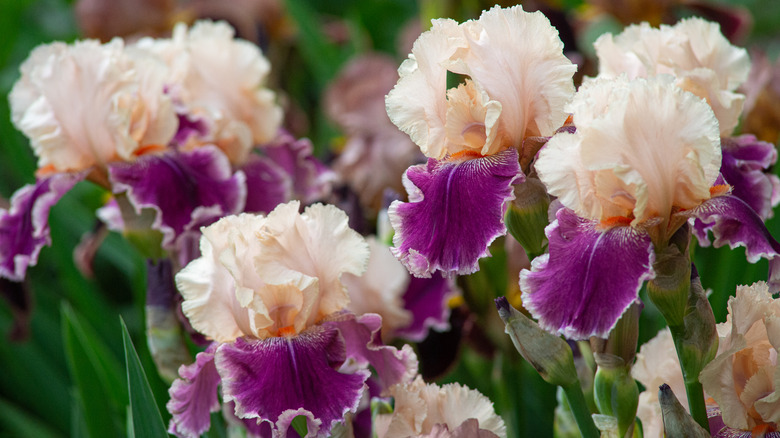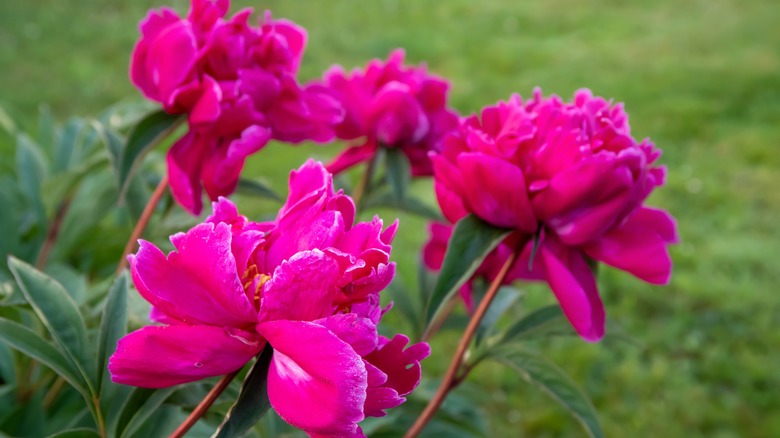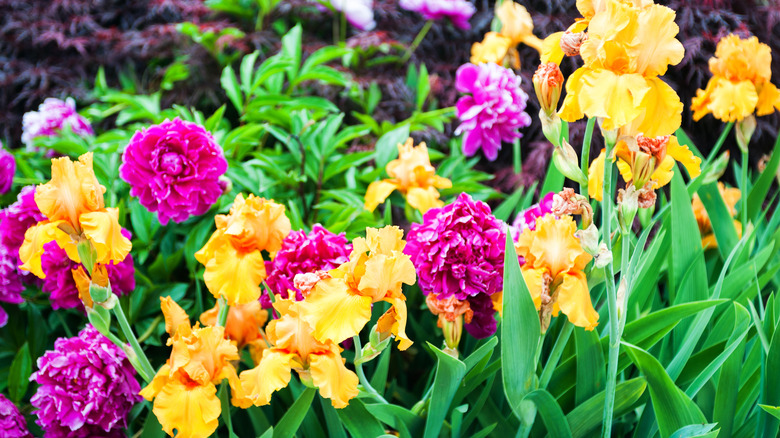The Garden Favorite Flower That Pairs Beautifully With Bearded Iris
Bearded iris flowers (Iris x germanica) are a beloved sign that summer has almost arrived and that warm weather is here. Colorful and distinctive, their irresistible sweet scent and unusual shape are sure to make them stars of your spring garden. Most of these perennials don't grow taller than 2 feet, so they're perfect to plant in front of taller peonies, which often flower at the same time. The two flowers pair together beautifully and create a riot of color in your late spring and early summer garden.
Bearded irises are known for their rainbow of colors, so it's appropriate that they share their name with the Greek goddess of rainbows. It's not difficult to grow and care for bearded irises and they generally return year after year with little help. Growing from rhizomes, they thrive in slightly-acidic, well-draining soil that's rich in organic matter; avoid planting them in clay-heavy areas. While irises grow and bloom best in full sun, they can also handle part shade. Hardy in USDA zones 3 through 9, bearded irises' rhizomes can be lifted and stored for winter if necessary in extremely-cold regions.
Growing peonies
Herbaceous peonies (Paeonia lactiflora), like irises, are classic late-spring to summer perennials. To successfully grow peonies, don't plant them too deep, as that can prevent flowering — only place them about 2 inches below the soil line. Hardy in USDA zones 3 through 8, peonies grow best in full sun and may not flower well in shade. Just like bearded iris flowers, they thrive in well-draining soil with a slightly-acidic to neutral pH and struggle when grown in soggy soil with poor drainage. Peonies often require a few years to become established before they start blooming heavily, but they are more than worth the wait.
While peonies may not come in quite as many colors as irises, they still have an impressive shade range, including reds, pinks, whites, and yellows. The large fluffy flowers are often fragrant and may smell reminiscent of rose or citrus, making them ideal plants for anyone who loves roses but hates thorns. After peonies finish blooming for the year, be sure to leave their foliage until it begins to yellow, as this will improve the next season's flowers.
Growing irises and peonies in the garden
As both bearded irises and herbaceous peonies require similar soil and lighting conditions, it's no surprise that they make a great pair in the garden. Peonies often grow as tall as 3 feet, so they work best in the back of borders with the slightly-shorter bearded irises in front of them. Low-growing bedding plants like pansies (Viola × wittrockiana) can be a great addition in front of the irises to fill in a large space.
Both irises and peonies often require staking to prevent their large flowers from flopping over and benefit from low nitrogen fertilizers, both in early spring and again after they have flowered. Neither irises nor peonies flower well if they have too much nitrogen. While irises require dividing every few years, peonies do not need to be divided. As both irises and peonies generally finish flowering by early summer, consider planting annual wildflowers or other later-blooming flowers around them to ensure you have colorful blooms all summer long.


